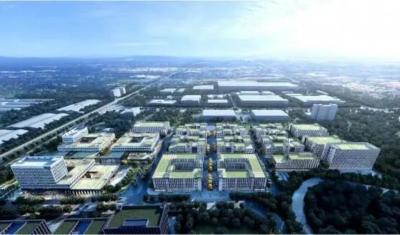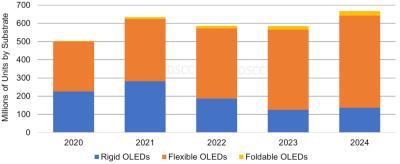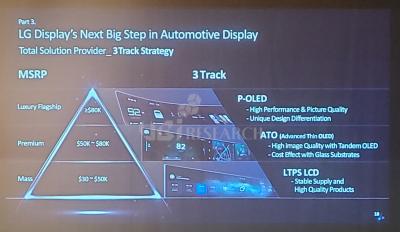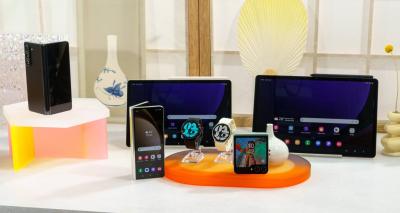OLED is an emerging display technology that enables beautiful and efficient displays and lighting panels. OLEDs are already being used in smartphones, laptops, wearables, tablets and TVs, and many of OLEDs are flexible ones.
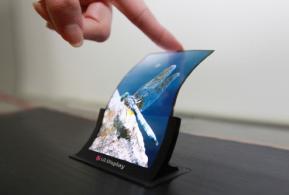
A flexible OLED is based on a flexible substrate (usually polyimide). The first generation of OLEDs produced on these were not really flexible from the user perspective. The device maker bends the displays, or curves it - but the final user is not able to actually bend the device. These first-gen flexible OLEDs are adopted many premium smartphones, for example the Samsung edge-type Galaxy phones or Apple's latest iPhones. A plastic-based OLED has several advantages especially in mobile devices - the displays are lighter, thinner and more durable compared to glass based displays.
Second generation flexible OLED displays can be bent by the user - these can be used for example to create foldable smartphones - the first range of which started shipping in 2019 and today these are quite popular. Rollable OLEDs are likely to enter the market soon, offering the ability to create scrollable devices. In 2019, LG launched the world's first rollable OLED device - the 65" Signature OLED TV R but in 2024 it discontinued this device as its price was too high for consumers.
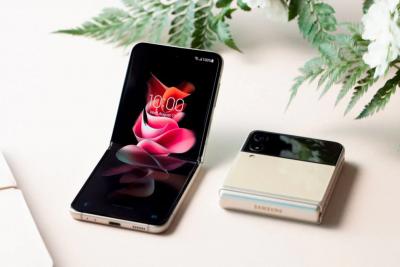
Where to buy flexible OLEDs?
While several companies (including Samsung, LG, BOE and others) are producing OLED displays, it is not straightforward to find a good and reliable supply of these displays.
If you are interested in buying a flexible OLED panel for your project or device, look no further. Our OLED Marketplace offers several flexible OLEDs, which can be ordered through us with ease.
BOE signs the official contract with Chengdu's local government to build its 8.5-Gen IT AMOLED line
BOE has been planning a 8.5-Gen flexible IT AMOLED Line for a couple of years, and in November 2023, following some delays, the company officially announced its plans for the new fab. Now we hear from China that the Chengdu local government, together with Chengdu's Hi-Tech Industrial Development Zone, have signed the contact with BOE to build the new plant.
The total investment in the fab is expected to reach 63 billion Yuan (over $8.7 billion USD). The fab will have a capacity of 32,000 monthly substrates (2290x2620 mm), and is expected to begin production by Q4 2026 (total construction time will be 34 months, according to the plan).
TCL CSoT showcases transparent, flexible and inkjet printed OLED displays at CES 2024
TCL CSoT demonstrated several OLED displays at CES 2024. first up we have an automotive 10.1” transparent OLED display, that offers 52% transparency. CSoT says that this is a "Smart Transparent" display, although it's not clear what is meant by that exactly.
The second display is a 14" 2.8K (2880x1800, 240 PPI) inkjet printed hybrid OLED. This is the first time that CSoT has printed a laptop AMOLED display. It uses an IGZO (Oxide-TFT) backplane, and offer a variable refresh rate (30-120Hz) to expand the battery life. This display was first shown last month, when TCL stated it is on track to start mass producing OLEDs using an inkjet printing process in the second half of 2024.
Motorola unveils a new bendable phone concept based on an LGD pOLED display
Motorola has demonstrated a new concept phone design, which they refer to as a Adaptive Display Concept. This is a smart bendable phone, that sports a 6.9" FHD+ (2220x1080) flexible AMOLED display produced by LG Display.
The adaptive display concept can be adjusted from a standard Android phone experience in a flat position to being wrapped for a wrist-worn experience or positioned in several stand modes.
DSCC: the OLED industry's capacity still far outstrips demand, recovery will not be easy
DSCC shared their estimation about display fab utilization (LCD and OLEDs), with some interesting comments. The slowdown in the industry, according to DSCC, is effecting all display makers, but the slowdown in demand for OLEDs is more severe and persistent. The industry is starting to recover, but this is a bumpy ride as the total capacity still far outstrips demand, and DSCC sees a slowdown in Q4 2023.
DSCC says that the slowdown for large-screen displays bottomed out towards the end of 2022, the slowdown in mobile devices only hit bottom in early 2023. There is still a weak demand for rigid OLEDs, mostly because of the lower demand for smartphones - but also because China-based flexible OLED makers are lowering prices to make them more competitive with glass-based OLEDs.
DSCC: smartphone OLED revenues to decline 11% in 2023, growth to resume in 2024
DSCC says that OLED smartphone shipments will total 585 million units in 2023, a 0.3% decline from 2023 in terms of shipments. Revenues will total $29 billion, a 11% decline from 2023. The soft demand for smartphones is due to a slow Chinese market, high inventories in the first half of 2023 and the global macroeconomic environment.
For flexible OLEDs, DSCC expects a 14% growth in 2023 (shipments) and a 9% decline in revenues - as average sale price has dropped 20%. The industry saw aggressive price cuts by Chinese phone makers - to the point where a flexible OLED made in China is cheaper than a rigid OLED made in Korea (by SDC). The market share of flexible OLED smartphones will reach 75% in 2023 out of the total OLED smartphone market.
LG Display reveals its automotive display strategy and its latest OLED customers
LG Display detailed its latest automotive display strategy. The company is now offering three product family. For luxury flagship cars (over $80,000 in cost), the company is offering its P-OLED flexible panels, that offer high performance coupled with design freedom.
For premium cars ($50,000 - $80,000) the company offers rigid OLEDs, that offer high image quality and a tandem OLED architecture for increased efficiency and lifetime. These displays are lower in cost compared to LG's P-OLEDs, and LG brands these as ATO (Advanced Thin OLEDs) as they adopt TFE encapsulation over a glass substrate. For mass market cars ($30,000 - $50,000) LGD offers LTPS LCDs.
Samsung announces new foldable phones, tablets and smartwatches, all based on AMOLED displays
Samsung announced several new devices today, all utilizing AMOLED displays. We'll start with the two new foldable phones, the Galaxy Z Fold5 and Z Flip5. The Fold5 offers a foldable 7.6" 120Hz 1812x2176 foldable AMOLED display, and a 6.2" 120Hz 904x2316 cover AMOLED. The phone has a Snapdragon 8 Gen 2 chipset, 12 GB of RAM, up to 1TB of storage and a triple camera setup.
Samsung's Galaxy Z Flip5 smartphone offers a foldable 6.7" 120Hz 1080x2640 foldable AMOLED display, and a small 3.4" 720x748 cover Super AMOLED display. The phone has a Snapdragon 8 Gen 2 chipset, 8 GB of RAM, up to 512GB of storage and a dual camera setup.
Tianma, BOE and Visionox report their latest financial results as profits decline, but demand for OLED panels increases
Three display makers in China (BOE, Tianma and Visionox) reported their preliminary financial results for the first half of 2023. It seems as if all companies are facing a sluggish economy and lower demand for displays - but the OLED business is actually seeing increased demand.
We'll start with BOE, that expects an operating profit of around 700-800 million Yuan ($97-110 million USD) in the first half of 2023, a decrease of around 90% from last year. BOE says that it is starting to see demand increasing as the year progresses.
Visionox shows its latest OLED prototypes and technologies at Display Week 2023
China-based Visionox demonstrated many OLED displays and new technologies at Display Week 2023.
So first up, we have some rollable and foldable OLEDs. You can see some impressive looking such flexible OLEDs in the video above, and Visionox featured many such displays at their booth.
TCL CSoT shows new foldable and rollable inkjet-printed OLED prototypes
TCL CSoT had several interesting new OLED demonstrations at SID DisplayWeek 2023, all of which were produced by inkjet printing, which shows the company's commitment to the new production process.
First up is the company latest inkjet-printed panel, this time CSoT showed a 8K (7680 × 4320) 65" TV panel that is foldable (with a bending radius of 25 mm). The panel offers a peak brightness of 800 nits, a response time of under 1 ms and a refresh rate of 120Hz.
Pagination
- Previous page
- Page 2
- Next page
